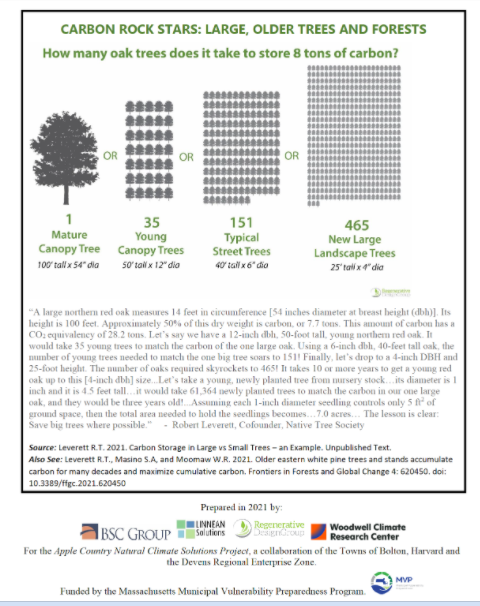Back on January 15, 2021, HooRWA held our annual State of the Rivers Conference. This year it was on Zoom. Glasgow on the Hoosic- The Climate Crisis after COP26 brought together 3 panelists to share their expertise on how climate change could affect the region. Watch the video HERE
After Bill Moomaw’s talk on how trees can help mitigate climate change, several of you requested a tree list for local action. Here it is!
Trees for Home with Considerations for Climate Change
by Bill Moomaw
Review this list of selected high-carbon, mostly native trees. Some species like Canadian hemlock, American Beech, and all species of Ash are vulnerable to insects and diseases and not recommended.
Deciduous trees:
- Red Oak (Very high carbon density; large)
- White Oak (Very high carbon density; large)
- Black Walnut (Very high carbon density; large)
- Sugar Maple (Very high carbon density, bright yellow fall foliage)
- Red Maple (Bright red fall foliage, red spring flowers; Good town trees)
- Poplar (Rapid growth, short lived)
- Black birch (Smaller, attractive dark smooth bark)
- Yellow birch Smaller, unusual bark; very long lived)
- Paper birch (unique white bark, relatively short lived)
- Basswood (Very long lived-several hundred years; sweet smelling flowers; excellent town trees)
- Cherry (Beautiful tall trees)
- American Elm (Beautiful shape; disease resistant varieties; planting may help reestablish species)
- American Chestnut (Disease resistant varieties available; planting may help reestablish species)
Evergreen trees (These trees grow very tall and with their year round needles provide constant shade:
- White Pine (Can grow exceptionally tall and relatively rapidly)
- Norway spruce (Non-native, but a strong grower)
Most other evergreen species are smaller and many are attractive as ornamentals.
Key factors for planting trees in your yard:
- Trees help cool by shade and evaporation of water from their leaves and needles.
- Determine soil type for best growth performance for each species (U Mass has soil data)
- Do not plant trees where they might cast shade on present or potential future solar panels (South-facing roofs)
- Do not plant trees directly under power lines or they will be carved up into grotesque shapes to accommodate the wires, and may cause power outages during storms.
- Provide sufficient space for street trees in town. Often the strip between the street and the sidewalk is very narrow making these trees vulnerable to being uprooted by wind storms, and their crowded roots lift up the sidewalk.
- Solar arrays are essential, but forests and large old trees should not be cut down to accommodate them. There are many other available sites. If your home is unsuitable for solar panels, consider a community solar garden with neighbors.
Below is a figure that compares the number of individual Red Oaks of different sizes and approximate ages required to have the same amount of carbon as a single large older tree that holds about 8 tons of carbon, the equivalent of 29 tons of carbon dioxide that is NOT in the atmosphere. These estimates were developed by Robert Leverett an expert in old growth trees and their location in New England.
